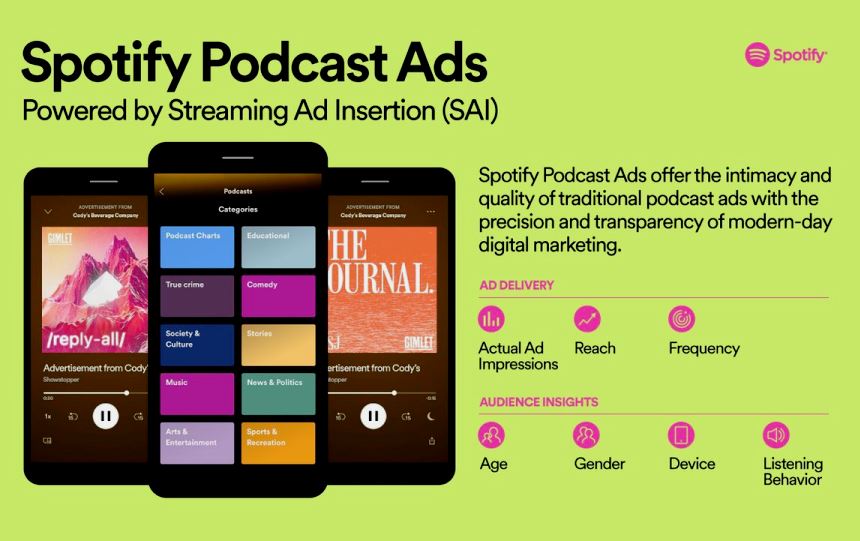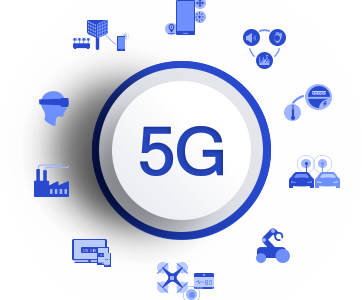By Claire Buffet
On 16 February 2022, Spotify announced two more acquisitions in the podcasting business: Podsights, an advertising measurement tool, and Chartable, an analytics platform for podcast publishers. The streaming giant clearly stays on target by adding these podcast technology companies to the long list of its latest investments in podcasting.
In fact, in 2019, Spotify entered the race to become the global leading streaming audio platform, and no longer just a music streaming service. Since then, more than $1 billion has been spent in various podcast acquisitions. It started with the takeover of several podcast networks and studios (Anchor and Gimlet in Q119, Parcast in Q219, The Ringer in Q120 for instance), then the exclusive licensing deal for one of the most popular podcast in the world, The Joe Rogan Experience, and finally took a turn by acquiring several technology podcast companies, like Megaphone (Q420). Spotify was then adding a new ad-focused string to its bow, aiming for advertisers and podcast publishers.
RELATED COVID-19 Has Done More To Accelerate Digital Adoption Than 15 Years Of EU Regulation
As a continuation of its buyout strategy, Spotify revealed last Tuesday the launch of The Spotify Audience Network, touted as the first audio advertising marketplace, where advertisers and publishers can connect and properly reach listeners.
Spotify’s outcomes are clear: investments eventually paid off
If many were skeptical about the actual fallouts of this high-priced bet put on podcasting by the streaming giant, the last results published are actually quite convincing. Only shortly after having laid solid foundations for its podcast ecosystem, Spotify’s advertising revenues seem to benefit from a new impetus.

As we can see on the graph above, Spotify’s advertising revenues have been escalating since 2015. However, it hit a record in 2021, passing from $745 in 2020 to $1,208 million, thereby achieving a 62.15% increase within one year. Last October, Spotify’s CEO Daniel Ek confirmed the ad revenues’ leap forward was mainly fostered by podcasts. Meanwhile, the number of podcasts published on the platform continues to grow, reaching 3.6 million in 2021. In its last quarterly report, Spotify shared that 20% of the Monthly Active Users (MAUs) were engaged with podcasts, versus 16% in 2019.

Nevertheless, advertising still only accounts for a minority share in Spotify’s total revenue. In 2021, it represented 12.49% of the total revenue. This represents a 2 point increase compared to previous years, during which this share was quite stable, oscillating between 9.45% and 10.30%. If subscriptions are expected to remain the key revenue driver, advertising should grow stronger in the years to come. Daniel Ek disclosed that this could reach 20% of the platform’s total revenue at the end of 2022, and up to 30-40% in the next 5-10 years.
Towards a generalized shift in the music platforms’ revenue distribution ?
Traditionally, the music streaming platforms opted for a subscription-based model, largely getting their revenue from premium subscribers. Spotify is the quintessential streaming platform that succeeded in making space for both music and audio content. Through its several investments, the Swedish platform was able to take advantage of the increase in podcast consumption. Spotify used it as a leverage to implement partnerships with publishers and strengthen both its catalog and legitimacy as a proper audio platform. This approach proved to be an effective argument to convince advertisers to invest in podcasts. It took a substantial investment, which we suppose will be a tough act to follow by Spotify’s competitors.
If in the future we could expect this strategic change to create incentives among the other stakeholders, it will most likely take some more time. For a global shift in the revenue sharing of the traditional music streaming platforms to happen, these platforms have to set their own mechanisms for podcast monetization. In any case, there is no doubt that we ushered in a new chapter in podcast advertising that will subsequently stimulate creation.
Claire Buffet | Analyst
First published Monday, 07 March, 2022 @ Dataxis
































